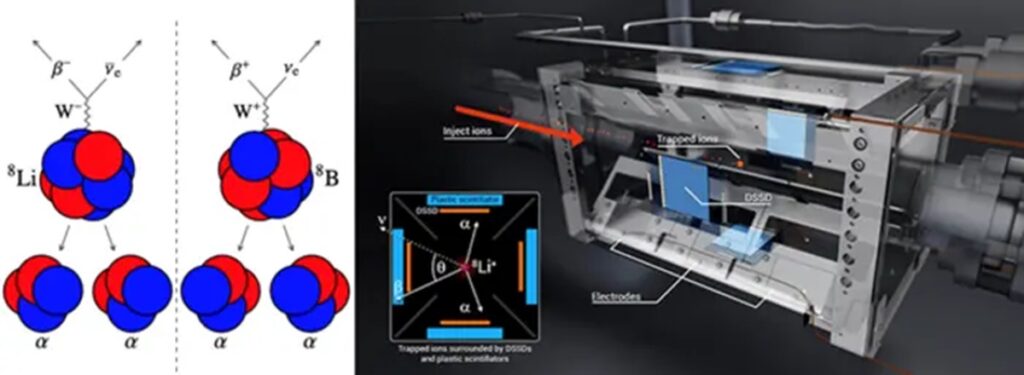The Standard Model of Particle Physics offers a better understanding of the forces that describe the interaction between subatomic particles. The strong nuclear force, weak nuclear force, electromagnetic force, and gravity are the four fundamental forces that define our universe and are described by the Standard Model.
Strong forces generally have far bigger impacts than weak nuclear forces, making it difficult to study them.
In a new study, researchers aim to enhance our understanding of the weak nuclear force by analyzing beta decays of “mirror” nuclei, such as lithium-8 and boron-8. In mirror nuclei, the number of protons and neutrons is the same, but their arrangement is different. For example, lithium-8 has three protons and five neutrons, but boron-8 has five protons and three neutrons.
More accurate measurements of beta decay parameters have been made to identify a potential weak nuclear force component that the Standard Model is currently unable to explain. The weak nuclear force drives the process of nuclear beta decay, which occurs when a proton or neutron in a nucleus releases a beta particle (either an electron or a positron) and a neutrino.

Researchers look for deviations from the Standard Model predictions in the beta decays of mirror nuclei, such as boron-8 and lithium-8. However, so far, the results have remained constant with the Standard Model’s predictions. For this work, researchers combined advanced experimental techniques with theoretical frameworks. Their work could serve as the foundation for future advances in our understanding of the weak nuclear force.
A group of nuclear researchers from Louisiana State University, Argonne National Laboratory, and Lawrence Livermore National Laboratory measured the beta-decay characteristics of mirror nuclei, namely lithium-8 and boron-8, with extreme precision. Protons and neutrons make up the same number in mirror nuclei, but their configuration differs in each nucleus.
Researchers can learn more about the weak nuclear force by investigating mirror nuclei such as boron-8 and lithium-8. This force is the cause of beta decay, and mirror nuclei provide a unique chance to explore it more sensitively. The researchers anticipated that specific novel effects would result in opposing contributions inside the two nuclei. By contrasting the outcomes of lithium-8 and boron-8, researchers can distinguish these components and better understand the decay.
The researchers determined both the lithium-8 and boron-8 nuclei using a tool known as the Beta-decay Paul Trap. This apparatus can hold ions in a vacuum. By carefully examining the energies and orientations of the two alpha particles and the released beta particle, the researchers reconstructed the full decay properties, including the contribution from the neutrino, which cannot be directly observed.
Through this study, researchers wanted to look for discrepancies between the distribution of emission angles for the neutrino and beta particles, as predicted by the Standard Model (SM). Less than 1% variations might uncover novel facets of the weak nuclear force. Such high precision could only be attained by thoroughly understanding the detection system and apparatus. The scientists also created a brand-new theoretical framework known as the “Symmetry-Adapted No-Core Shell Model theory” to handle a variety of minute impacts brought on by the intricate nucleus environment.
The study’s findings produced the most precise measurements and more confidently validated the Standard Model’s predictions.
Journal Reference:
- A. T. Gallant et al. Angular Correlations in the β Decay of 8B: First Tensor-Current Limits from a Mirror-Nucleus Pair. Phys. Rev. Lett. DOI: 10.1103/PhysRevLett.130.192502
